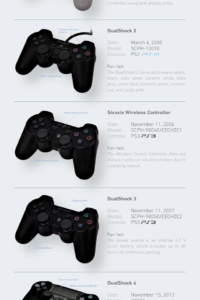The Evolving Videogame Input – Motion as Means of Interaction
Videogames dominate the entertainment industry because they necessitate interaction, transforming spectators into players. This interaction has assumed multiple forms. Miguel Mira explores how motion as a means of interaction seems to have found a home as an integral part of virtual reality.
Videogames have evolved immensely since their humble origins in the 1950s (Donovan, Garriott 2010). They now dominate the entertainment market, totaling a net worth growth of 183 billion in 2021 (Clement, 2022), a trend that continues from 2009, the first year in the UK in which videogames sold “more than DVD and music sales combined, and more than four times cinema box office takings” (Chatfield, 2009). The defining characteristic that sets apart videogames from other forms of entertainment is that they necessitate user input. The input of the player is always met with an automatic reaction from the game in real time. This fundamental characteristic affords agency to the player, who is in turn engrossed and immersed by the ability to directly influence the outcome of their experience.
Historically, we have employed multiple ingenious devices from nobs, to buttons, joysticks, touch screens, keyboards, computer mice and vibrating controllers, to register the player’s input. This experimentation has led to the standardization of button and joystick layout. For example, Sony’s PlayStation DualShock controller has had the same button layout since 1994. This might seem that progress with controller design has stagnated but, on the contrary, this is a positive for players as it signifies the medium’s maturity. Much like the QWERTY keyboard that has remained the same since 1873 (Noyes, 1983), so too have console controllers stabilized and standardized their design and layout. This means that the muscle memory acquired by players from previous console generations is inherited by the future iterations of the device.


Despite our acquired proficiency with manipulating videogames via controllers, multiple attempts have been made by videogame companies to evolve in the direction of registering user input via motion without controllers by tracking the player's motion. In the aforementioned case, Sony launched the EyeToy, a miniature camera “that attaches to the PlayStation 2 and translates body movements into a video game” (Robischon, 2003). The device received input directly from the player’s motion. Sandy Spangler, game designer commented: “what we always try and do with our games is make a direct correlation between the motion that you're doing and the action on screen, the effect you're having on the game” (Welsh, 2008). This direct correlation proved very popular at the time amongst casual gamers. When Microsoft’s Xbox attempted to implement motion controls by launching the Kinect add-on for the Xbox 360 in 2010 it won “the Guinness World Record for being the Fastest-Selling Consumer Electronics Device”(Hester, 2020). Yet obligating players to have the device on and plugged in to use the newer Xbox One, created a controversy that Microsoft ultimately had to amend, “announcing that the console would function without it” in August of 2013 (Hester, 2020).
It would seem that motion input is limited to casual gamers as user input. However, with the emergence of Virtual Reality (VR) videogames and stand-alone VR Head Mounted Displays (HMDs), like the Oculus Quest 2, motion input seems to be resurging as an essential part of player input because it reinforces the sensation of VR immersion. By moving two controllers the player can seamlessly experience the manipulation of a virtual object in game. Because the virtual world’s physics engine reacts naturally to the player’s motion input, their sense of immersion and engagement is deepened. The ability to grab and manipulate objects in VR works so naturalistically to immerse players, that VR videogames like Job Simulator (2016), Calm Down Stalin (2016) and Cooking Simulator VR (2021) have become very popular titles, despite the fact that the aforementioned games still use controllers to register the player’s motion.

This is significant because it amplifies the range of player input exponentially. Tasks that were previously the press of a single button, such as reloading in a first-person shooter, now become an array of motion based inputs. Previously players could rely on a single button to reload all weapons, a “one button press fits all” solution. Yet, VR videogames that utilize motion input (Onward 2016, Pavlov 2017, Bone Works 2019) employ a steeper learning curve when preforming simple tasks with a new virtual object. Where once operating a pistol or a bazooka shared the same button’s push, they now require completely different motion inputs.
Even with these complicated systems the large majority of VR games and experiences still rely on the player utilizing two controllers to register the motion inputs. HMDs like the Vive, Valve Index and Oculus use two motion sensing controllers as the primary means of interaction between the player and the virtual environments. But there seems to be an interest in pushing motion input gameplay even further. Currently, titles such as Hand Physics Lab (2020) and Elixir (2020) exemplify what an HMD can do in conjunction with motion tracked hands. By registering hand motion via cameras, a technology akin to the aforementioned Eyetoy and Kinect, the player inputs motion without controllers, freeing the player from the “button press”. This creates a direct correlation with the player’s actions and the reactions of the virtual environment. This is a double-edged sword for VR programmers, because they no longer have button-binding restrictions for the actions they wish to program on their videogames, yet they must also program considerably more actions to create a truly seamless experience for the player.
Utilizing motion input in VR functions to great effect to maximize the sensation of immersion because the hand is freed from the restriction of button pressing. Considering the fundamental characteristic of a videogame is interaction, it is understandable that videogame developers push to deepen the direct correlation between player action and game reaction. Freeing players from the controller seems to be the next logical step.
Because using motion input results to great effect in VR, we can hypothesize this is where motion input will find a definitive home in the videogame milieu. Yet this will not be the norm for the foreseeable future, as most videogames are still comfortably played via Mobile, Console or PC.
REFERENCES
Chatfieled, Tom. “Videogames Now Outperform Hollywood Movies.” The Guardian. Guardian News and Media, September 27, 2009. https://www.theguardian.com/te....
Clement, J. “Video Game and Gaming Industry Revenue 2021.” Statista, February 28, 2022. https://www.statista.com/stati....
Donovan, Tristan, and Richard Garriott. Replay: The History of Video Games. Yellow Ant, 2010.
Hester, Blake. “All the Money in the World Couldn't Make Kinect Happen.” Polygon. Polygon, January 14, 2020. https://www.polygon.com/2020/1....
Nathie944, director. YouTube, YouTube, 23 May 2019, https://www.youtube.com/watch?.... Accessed 7 July 2022.
Noyes, Jan. “The QWERTY Keyboard: A Review.” International Journal of Man-Machine Studies 18, no. 3 (1983): 265–81. https://doi.org/10.1016/s0020-...(83)80010-8.
Robischon, Noah. “Smile, Gamers: You're in the Picture.” The New York Times. The New York Times, November 13, 2003. https://www.nytimes.com/2003/1....
Streams, Kimber. “The Evolution of the PlayStation Controller (1994-2013).” Laughing Squid, 10 Sept. 2013, https://laughingsquid.com/the-....
Welsh, Oliver. “Eyeing the Future.” GamesIndustry.biz. GamesIndustry.biz, November 24, 2008. https://www.gamesindustry.biz/....
© Miguel Mira and Leiden Arts in Society Blog, 2022. Unauthorised use and/or duplication of this material without express and written permission from this site’s author and/or owner is strictly prohibited. Excerpts and links may be used, provided that full and clear credit is given to Miguel Mira and Leiden Arts in Society Blog with appropriate and specific direction to the original content.



0 Comments